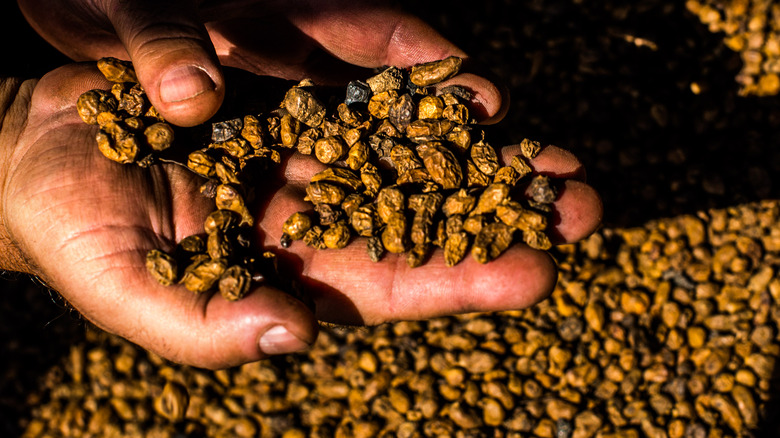Everything You Need To Know About Tiger Nuts
Almond, cashew, peanut ... common names for common foods. But the tiger nut, now that's a new one: A name that manifests regality, storied history, and top-of-the-line nutrition. Actually not a nut but a tuber (basically the underground part of a stem that has thickened, like potatoes or yams), the tiger nut has grown in popularity in Western markets in recent years, no doubt owed primarily to its awesome name, but to a lesser extent maybe also because of its culinary versatility, its wholesome and robust flavors, and its believed health benefits.
These little pseudo-tuber/nuts look as if a peanut's growth was stunted and then it decided it wanted to look as much like a tiny clean potato as it possibly could. Then added stripes. Odd but commonly lauded as a "superfood," the tiger nut's star has been rising and as you see more and more tiger nut products at your local supermarket or on the neighborhood café menu, you may want to know about them beyond their eye-catching name.
The origin and spread of the tiger nut
NPR reports that some scientists believe tiger nuts were consumed by early hominids, 2 million years before homo sapien can be seen in the fossil record. One study published in the peer-reviewed journal PLOS One suggests the diet of the now-extinct hominin Paranthropus boisei consisted of large amounts of tiger nuts, which contributed to the hominin's nickname "Nutcracker Men."
According to Forbes, notable and well-documented early uses of tiger nuts date back to the Neolithic period — or late Stone Age — during which time tiger nuts became one of the very first plants to be intentionally and meaningfully cultivated by humans for consumption. Found all around the world but primarily in the Eastern hemisphere, tiger nuts grow wild and free, from Southern Europe to Madagascar to Africa to some places in India and everywhere in between.
Per the business outlet, agronomy of tiger nuts started in Egypt, and from here spread to other parts of North Africa eventually crossing the Strait of Gibraltar and making its way to the Iberian peninsula. Given its wide reach and utility for both growing and eating, it is no surprise when ancient recipes and long-standing traditions seem to involve tastier and tastier methods of utilizing tiger nuts.
How and where do tiger nuts grow?
Cyperus esculentus — also called chufa, atadwe, yellow nutsedge, or earth almond — the tiger nut gets its most well-known name from the pattern of stripes that can be found riding their way across the body of the tiny tuber. According to Garden Culture Magazine, the plant is extremely resilient and can take advantage of fast-acting anthropogenic and natural changes to the environment better than most plants. Tiger nuts need a mild climate to grow and are very tolerant of different soil conditions and constitutions, their incredibly wide native range is a testament to the hardiness of the plant.
Their stalwart nature makes them relatively easy plants to grow, so tiger nuts have become a valuable cash crop and subsistence crop in many different places around the world. In other parts of the world however, tiger nuts have become invasive and are considered a weed, per NPR. These little striped warriors seem to be able to grow anywhere and have infested many parts of Mexico, the United States, and in several Mediterranean countries.
How to use tiger nuts in cooking and baking
As the people of the Stone Age understood, tiger nuts have a wide array of uses both in food as well as in drinks. They can be eaten raw or cooked, but generally are boiled first to soften them up before consumption or preparation for cooking. Their subtle sweet and light nutty flavor make them a very popular snack in many African countries, particularly in Nigeria and Egypt.
According to Forbes, tiger nuts are used for oils and flours for cooking and baking, and of course tiger nut milk is often used in place of dairy milk for its ease of access and lack of lactose. With more starch than nuts and more protein than tubers, tiger nuts strike a balance that allows them to act as one with the benefits of the other.
Perhaps the most iconic historical and modern usage of tiger nuts comes from 13th-century Spain, though, where their unique properties were used to create horchata de chufa (literally "tiger nut horchata," via NPR, and pictured above) and later the West African versions of the beverage called kunnu aya, among other names.
The healthful benefits of tiger nuts
Never more than a quick Google search away from an online provider or nearby market, tiger nuts have experienced a surge in Western popularity as both a flavorful and nutritious snack and ingredient. According to WebMD, tiger nuts, like many other tubers, are a great source of fiber and can aid in digestion; they also have certain vitamins that are conducive to healthy living.
Despite the label of "superfood," there has actually been a minimal amount of research done concerning the overall health benefits of eating, drinking, or cooking with tiger nuts. They actually contain less protein than actual nuts and contain higher levels of carbohydrates, fats, and sugar. The health information may not be there completely, but the fact remains that tiger nuts are a delicious, popular, and versatile treat that can be used to wonderful effect as a substitute for flours, milks, nuts, and other tubers.
Most importantly, tiger nut is just a really cool name.




